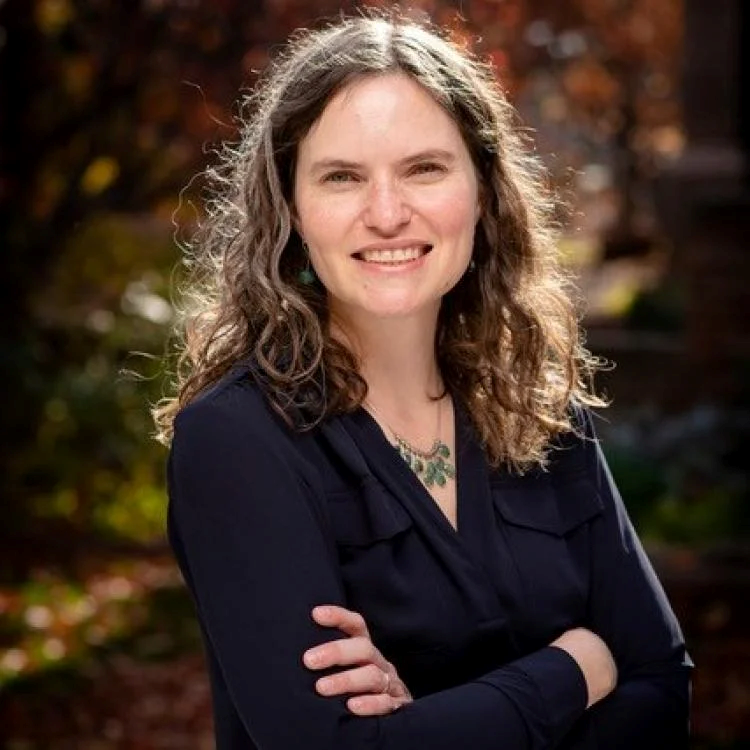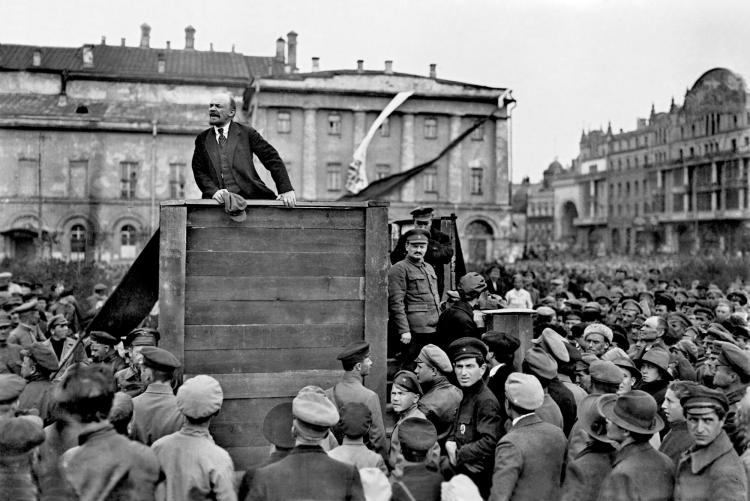This year is the 100th anniversary of the death of the Soviet Union’s first communist leader, whose legacy in Russia and former Soviet republics is complicated
When Erin Hutchinson, an assistant professor in the University of Colorado Boulder Department of History, visited Russia and former Soviet republics in the mid-2010s for her research on the former Soviet Union, statues of Vladimir Lenin were ubiquitous.
“When I first started traveling to Russia and the former republics in the 2010s, every town and village had their own statue. I had so many photos taken of me and my friends with Lenin statues that I have a (good-sized) photo collection,” says Hutchinson, whose area of specialty is the cultural and political history of the Soviet Union, with a particular focus on nationality and empire.
Today, many of those statues featuring the goateed face and the intense stare of the founding father of communist Russia have been torn down—especially in former republics like Ukraine. The statues, Hutchinson says, signify Lenin’s complicated legacy in post-communist Russia and eastern Europe.

CU Boulder researcher Erin Hutchinson studies the former Soviet Union and how its legacy affects Russia today.
January marked the 100th anniversary of Lenin’s death. Colorado Arts and Sciences Magazine recently spoke with Hutchinson about the leader’s legacy in Russia and its former republics, why leaders after Stalin wanted to return to Leninism and how he is viewed today in Russia. Her answers were lightly edited for style and condensed for space limitations.
Question: Set the scene for what was happening in Russia in the time leading up to the tsar’s abdication in early 1917, specifically as it relates to Lenin and his political party, the Bolsheviks.
Hutchinson: The Bolsheviks were one of many different groups that existed in the Russian empire. And the Russian empire under the tsar is a really oppressive place where you don’t have freedom of speech, or freedom of assembly or other basic rights. So, this oppressive government gives rise to these various political movements—a lot of which were either socialist or anarchist.
Lenin is a Social Democrat. He is a polarizing figure and, ultimately, he ends up splitting the party in two groups: the Mensheviks, which are the majority group, and the Bolsheviks, which are the minority.
Lenin is very driven and motivated to make revolution happen in Russia and he has the idea of having a small, disciplined, militant political organization rather than a broad-based party.
Question: A provisional government was formed after the abdication of the tsar. Many groups in Russia were vying for control at the time, so how is it that Lenin and the Bolsheviks were able to seize power?
Hutchinson: Without Lenin, the Bolsheviks probably would not have taken over in October of 1917. He’s the one who’s constantly pushing the Bolshevik faction within the Social Democrats to seize power. So, in that regard, he’s a central figure.
They (Bolsheviks) staged a coup in October, which had popular support. They kick out the provisional government that had been running the country since February and they take over all the important communication points and the seat of government, the Winter Palace.
Lenin is really the only person who has the vision to see, ‘If we want to take over, we just need to seize power now.’
It’s Lenin’s drive for power—along with his ability to see things that other political parties did not and to exploit the weaknesses of the other parties—that gives the Bolsheviks the advantage.

A statue of Vladimir Lenin in Osh, Kyrgyzstan. (Photo: Adam Harangozó)
For example, the Bolsheviks were the only party that (advocated) for Russia to pull out of the war (World War I, fighting Germany), because they recognized that the war was extremely unpopular in Russia. The country was getting defeated left and right on the eastern front, so this was a popular opinion with the masses. It’s a reflection of Lenin’s political cunning to espouse policies the other political parties were not but which were popular with the masses.
Question: What are some of the biggest legacies Lenin left on Russia and its territories?
Hutchinson: Lenin has a really big impact in terms of how the Soviet Union is structured, which is what I study. He’s the one who believes the Soviet Union needs to be structured as one country with many republics in it. He was the one who said that instead of unitary government, the different ethnic groups should have their own republics within the USSR. And he did this because, during the civil war that followed the 1917 revolution, he had seen the strength of separatist nationalists in the borderlands of the Russian empire, because he fought against them.
So, he knew that nationalism was strong, and this way (having independent republics) was his way of appeasing them. He said, ‘OK, we’ll have these different ethnic groups have their own little republics. They’re not going to be politically independent, but they will have their own institutions and culture.’
Stalin (Lenin’s successor) actually didn’t want that. He didn’t want to be organized along ethnic lines, which is interesting, because Stalin was Georgian.
Lenin established many things that determined the very structure of the USSR until it collapsed. And indeed, many have argued that the structure was the reason the USSR collapsed. It was relatively easy for the Soviet republics to break away because they already had ethnically consolidated populations and many of the same institutions as independent states.
Question: After Lenin’s death, he became a cult-like figure in the Soviet Union, correct?
Hutchinson: He’s definitely this ubiquitous figure in the Soviet Union. They called him Uncle Lenin. Every place where Lenin ever slept had a plaque that said, ‘Lenin slept here.’
Every school child learned about Lenin and his positive qualities that they should emulate. The myth of Lenin was very much a part of every Soviet child’s experience growing up; you can compare it to George Washington in the U.S.—but maybe on steroids.

Vladimir Lenin giving a speech in Moscow, Russia, May 5, 1920. (Photo: Grigory Petrovich Goldstein)
And, of course, everyone knows that his body is preserved in a mausoleum (in Moscow) and that’s where Soviet leaders would stand when they had parades in Red Square. They would stand in Lenin’s mausoleum and wave to people. It was just a ubiquitous part of everyday life.
Question: Lenin was essentially a follower of the political philosophy of Karl Marx. At what point did he become elevated to where people talk about Marxism-Leninism as a political philosophy?
Hutchinson: I think we would use a term like Marxism-Leninism to describe what Lenin added to Marxism. Because in many ways, you can see Lenin is going against some of the original ideas of Marx, because Marx thought that the working class revolution was going to happen in the most advanced industrialized countries in Europe, like Germany and Britain. Well, that didn’t happen.
Lenin believed that would eventually happen, but he also argued that the proletarian revolution could happen in places that did not have these advanced industrial economies. And Russia was still a country in 1917 where about 80% of the population were peasants and occupied with agriculture.
Workers made up about 10% of the population of Russia at the time of the revolution, so it’s really audacious to say that this relatively small working class can take over a whole country. But the idea that you didn’t have to be an advanced industrialized country to have a communist revolution does spread to other countries.
In many ways, his ideas sort of deviate from the original Marxism, but in a way that ends up being really productive in that other people kind of glom onto them and they make their own changes, like Mao in China, who had the idea of a communist revolution driven by the peasantry, which Marx definitely didn’t think was possible.
Question: After Stalin’s reign, some of the Soviet Union’s leaders talk about wanting to return to Leninism. What do they mean by that, exactly?
Hutchinson: After Stalin’s death, (Soviet Premier Nikita) Khrushchev gives his famous secret speech in 1956 about all the Stalinist crimes that were committed and all the people that were killed in the terror of 1937. And Khrushchev does this under the name of a return to Leninism. So, he’s actually repudiating Stalin, but then he goes back to some of those more original policies of Lenin, including reviving official atheism and persecuting the church, saying that this is what Lenin really wanted; saying that atheism is an official part of the Communist Party program.
It’s fascinating, even with Mikhail Gorbachev in 1985, he was reading all the writings of Lenin and thinking ‘We need to go back to the original ideas of Lenin.’ So, he sees himself initially as a Leninist revolutionary, but working from within the system.

Vladimir Lenin giving a speech in St. Petersburg, Russia, in 1917. (Photo: public domain)
In some sense, every Soviet leader after Stalin is wanting to get back to Leninism.
Question: Russia stopped being a communist country with the breakup of the Soviet Union in 1991. How do Russians regard Lenin today?
Hutchinson: Today, the attitude of Russians toward Lenin is kind of complex, I think.
If you look at things from the perspective of the Russian regime today, (Russian President Vladimir) Putin wants to claim some of the positive parts of the Soviet legacy, such as the Soviet victory in World War II (even though) Lenin was long dead by then and Stalin is more closely associated with the war.
But there is also some ambivalence to Lenin because the central part of Putin’s ideology is that he is opposed to revolution. Just a couple of years after he came to power, there started to be revolutions in former Soviet republics, like Ukraine, and similar things happen in Georgia and Kyrgyzstan.
Putin perceives these as happening in his backyard, and he also doesn’t want them happening at home. Liberal groups oppose him, and some conservative nationalist groups oppose him and he’s stomping on all opposition. So, a figure like Lenin—who is a revolutionary—fits awkwardly with his worldview.
The other issue is that Putin’s ideology is increasingly influenced by Russian nationalism, which also has a very ambivalent attitude toward Lenin. Russian nationalists increasingly reject Lenin, seeing him as having destroyed the great Russian empire and many aspects of traditional Russian culture, like the church, the traditional village and these kinds of things.
Top image: Vladimir Lenin (center) in Moscow's Red Square. (Photo: public domain)
Did you enjoy this article? Subcribe to our newsletter. Passionate about history? Show your support.



